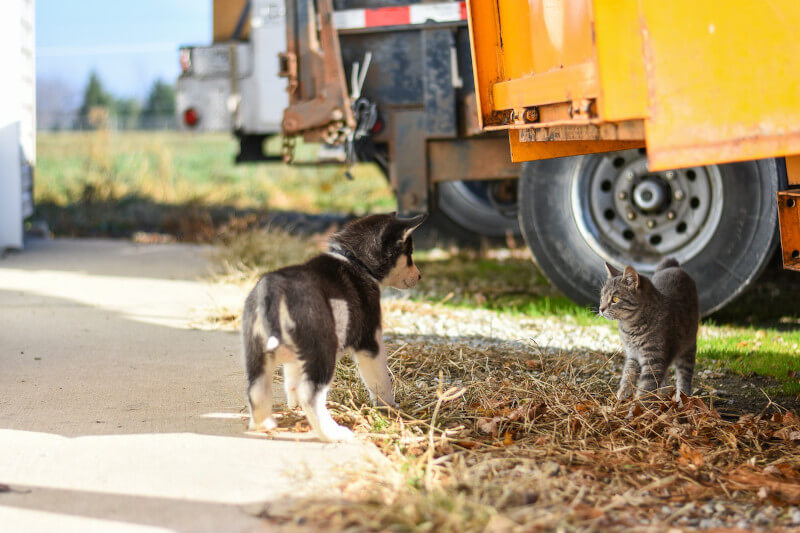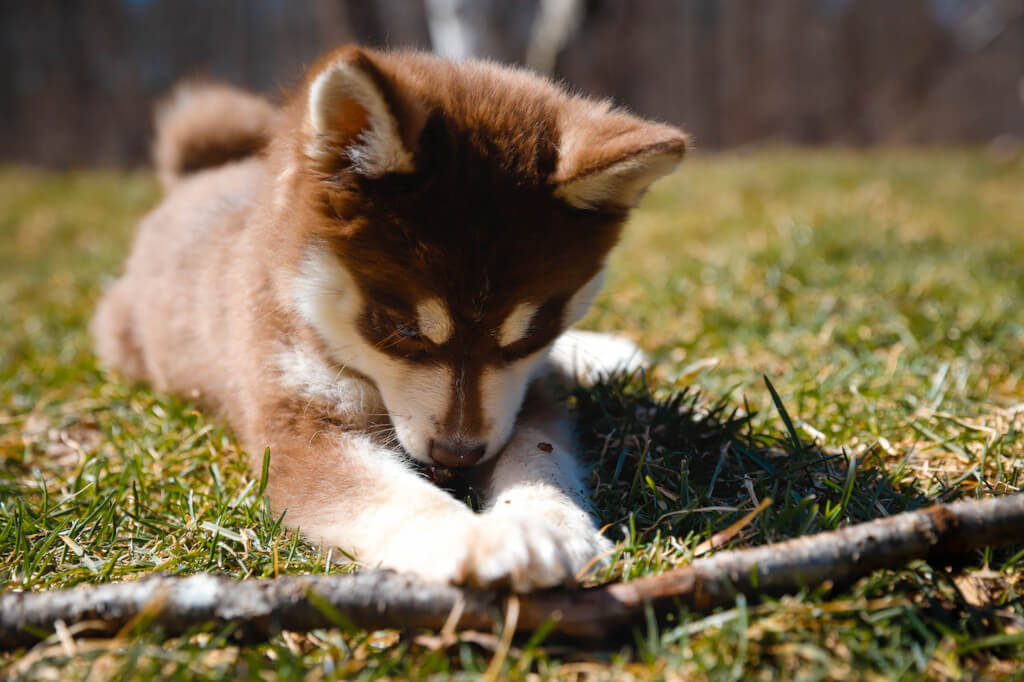Everything there is about the arrival of a new puppy is thrilling! After the adoption, the day has passed and your puppy has finally arrived home, you will find that they are the cutest thing ever. A natural follow-up question is how to socialise a new puppy with other dogs. (Or, for multi-pet owners: “How do I start introducing my puppy to other cats?”). It may seem to be a complicated challenge, yet there are certain useful methods for introducing your puppy to all of your animals and making sure that everyone gets along quite fine.
What is the Average Adjustment Period for a Dog to a New Puppy?
You might have less trouble introducing your dogs if your older dog has been well-socialised and is already comfortable around other pets. It’s important to remember that meeting a new puppy buddy can bring out a wide range of emotions in canines. It’s possible that some dogs have as much or more enthusiasm and vitality as a new puppy, in which case they’d love to play with another rambunctious canine. Play bowing and buttwiggling may now commence.

Most adult dogs, however, will have settled down by now, and some of them may not appreciate the puppy’s enthusiasm. It’s up to you, the pet pawrent, to read the body language of both the dog and the puppy, and to judge how well the introduction is going, as every situation is unique. There are many things you can do to help your current dog adjust to the presence of a new puppy. Initially, it is important to grasp the underlying dynamics at play.
Your older dog is not a “bad dog” if he or she displays a bad temperament when confronted with your new puppy, even if the older dog growls or otherwise reacts negatively. A young puppy still must be taught how to ‘interact in the dog’ – so owning an older dog to tell him to quiet down or back off is a great teachable moment to ingrain some etiquette in your puppy. Nevertheless, retain an eye on things on these initial connections, and act immediately before any biting or fighting can occur.
Get Together in a Safe, Neutral Location
Can an adult dog feel envious of a new puppy? They presumably will, therefore how must you introduce your puppy to your existing dog/s? Dogs – particularly those who have been loved, doted on, and granted plenty of love – can indeed be protective and wouldn’t ordinarily welcome an ‘invader’ in their environment who is likely to ask for a portion of your attention! No matter how well-established your dog is, he or she should not feel threatened by your puppy. This is the reason why it’s ideal to meet on neutral territory: on a walk, at the playground, or anywhere else that won’t trigger your dog’s defensiveness.
This meeting place should be calm and undisturbed so that both dogs and puppies can get to know each other without any unnecessary tension. Incorporate a partner or friend to assist you – somebody who also comprehends how essential these new gatherings are, and how to interpret pooch body language. If your older dog is satisfied with the puppy’s company, they would be playful and comfortable, but once they’ve experienced enough, you ought to be capable of understanding the indications and offer your dog room from the jiggly puppy
Encourage Them to Form a Close Relationship Through the Use of Rewards
You should give your dog a healthy treat for every positive response he has to his new puppy companion. Thank him for his patience, bowing, or general contentment while he watches the new puppy. Your dog will learn that the puppy’s presence is rewarding and that positive behaviour will be rewarded with treats if you follow this routine. Your new puppy should also be praised whenever it shows consideration for your dog’s personal space and behaves well. Now is the time to establish a positive association between treats and proper conduct in your puppy, a foundational link for later training classes.
Just the Two of You, Go for a Stroll
Some dogs may prefer treats, but most dogs prefer going for walks. It’s fine to take your senior dog for a stroll, as long as he doesn’t pull or act defensively while on the lead. Get a friend or partner to help you leash up your puppy and take it for a stroll around the block (your pup’s leash manners aren’t a top priority, so this is a good opportunity to get the pup used to wear a leash). Your dog and the new puppy will run into each other occasionally so that your dog can smell the puppy’s scent and vice versa. You can introduce the two with a stroll if the dog and puppy are calm.
Similar to how meeting on the neutral ground requires paying attention to both dogs’ and puppies’ body language, a leadership meeting requires the same attention. And if they stay calm and cheerful (let them explore, but don’t force them to fight), treat them and give them compliments to make sure they remember this time together fondly.
Getting Together and Talking in Private
No matter how well the off-leash and leashed introductions go, you and your dog and your new puppy will need to go home and live happily ever after. It’s crucial to introduce your new puppy to your dog in a neutral environment so that he doesn’t feel like he’s being treated unfairly.
Having a dedicated space where your dog and puppy can be kept apart for a couple of weeks or months can be helpful for everyone involved, whether you start introducing them at home or on neutral territory and bring them home together. (The length of time it takes for a dog and a puppy to adjust to one another will vary depending on the dynamics between the two). A baby gate is a great way to keep your dog and puppy apart while still letting them see and smell each other. When at home, the same rules must be followed:
- Monitor their actions
- always pay attention to how they are communicating with you through body language, and adjust your response accordingly
- If your dog and the new puppy are getting along well, praise them and give them treats.
- If your older dog shows signs of wanting some space from the new puppy, you must give him that space.
There Are Other Ways You Can Aid in the Introduction of Dogs and Puppies

Adult dogs rarely reach the level of enthusiasm seen in a playful puppy. Take your new puppy for a walk or have him do some other form of exercise to burn off some of that excess energy before he meets your dog. You’ll find that your puppy is more subdued when playing with your senior dog after doing this.
Get your puppy a bed, food, water bowls, playthings, and other necessities. It’s not a good idea to foster possessiveness or jealousy in your dog, even if he isn’t currently possessive or protective of his belongings. Make sure your furry friends have their own space to relax in, complete with their beds, food bowls, and toys.
Separate Your Dog and Puppy at Mealtimes for the First Few Weeks
This ensures there is no fear of starvation or competition for food. Do not encourage your puppy’s bad eating habits by allowing him to eat your older dog’s food if he is a fast eater and finishes his own (the same goes for the other way around). The offending dog’s lack of table manners is compounded by the fact that the other dog may become aggressive whenever the bully approaches its food bowl, possibly leading to bites and growls. Having young children who want to ‘feed’ your dog or puppy by hand is especially risky.
By keeping dog and puppy apart at mealtimes, you can give them both the space they need while also teaching them boundaries. Eventually, you can introduce them to eating together without any tension or competition by putting a baby gate between them. If your dog or new puppy is a fast eater, you can get them a “slow feeder” bowl or a snuffle mat to teach them to eat more slowly and to chew their food more thoroughly.
Do You Want to Know How to Introduce Your New Puppy to Your Cats?

In the same way that you would treat and reward a new puppy, you should do the same if you already have cats at home and are looking to add a new member to the family. Cats are the apex predators in your home, and they may not take kindly to a new dog without a lengthy discussion with you first.
Make sure your new puppy is relaxed and not overstimulated by taking it for walks and playing with it first before introducing it to cats. To succeed here, it’s crucial to mirror your cats’ level of enthusiasm. Avoid coercing your cats into meeting the new puppy. If your cats are having trouble adjusting to your new puppy, a crate or playpen may be the best solution. It’s better to give your puppy a chew toy or a snack if he’s overwhelmed and wishes to gnaw on something other than your cat or cats. It’ll be easier for your active puppy to keep his distance while your curious cats explore their new surroundings.
Dogs should be praised for good behaviour, and cats should be praised for restraint and politeness (and not bullying your puppy). Cats and puppies can learn to get along and treat each other as a family with time and effort.
When Should You Start Socialising Your New Puppy With Other Dogs?
Your new puppy needs to meet and interact with other dogs and be socialised regularly, but that doesn’t give you the right to go up to any dog you see and anticipate a friendly hello, either from the dog or the owner. The first rule of taking your puppy outside is always to have him on a lead and under your control. Two, you need to get permission from the other dog’s owner before letting your puppy approach another dog. Not every dog or owner will welcome your puppy’s overtures simply because your puppy is friendly, submissive, or in need of socialisation.
Taking your new furry friend to puppy school is your best option if you want to ensure he gets the full benefit of socialisation without having to worry about him being rejected by strangers out walking their dogs. This way, he’ll have the opportunity to interact with a wide variety of other animals in a controlled and focused setting.

